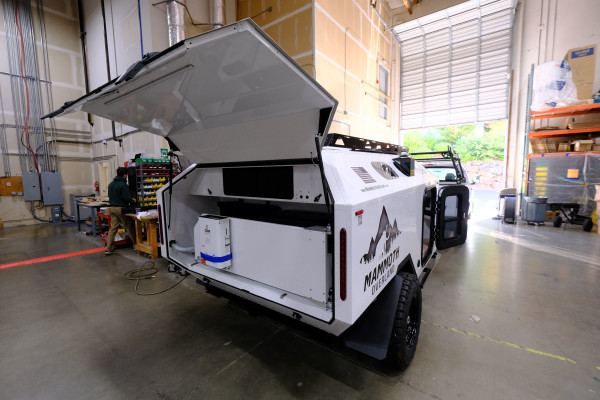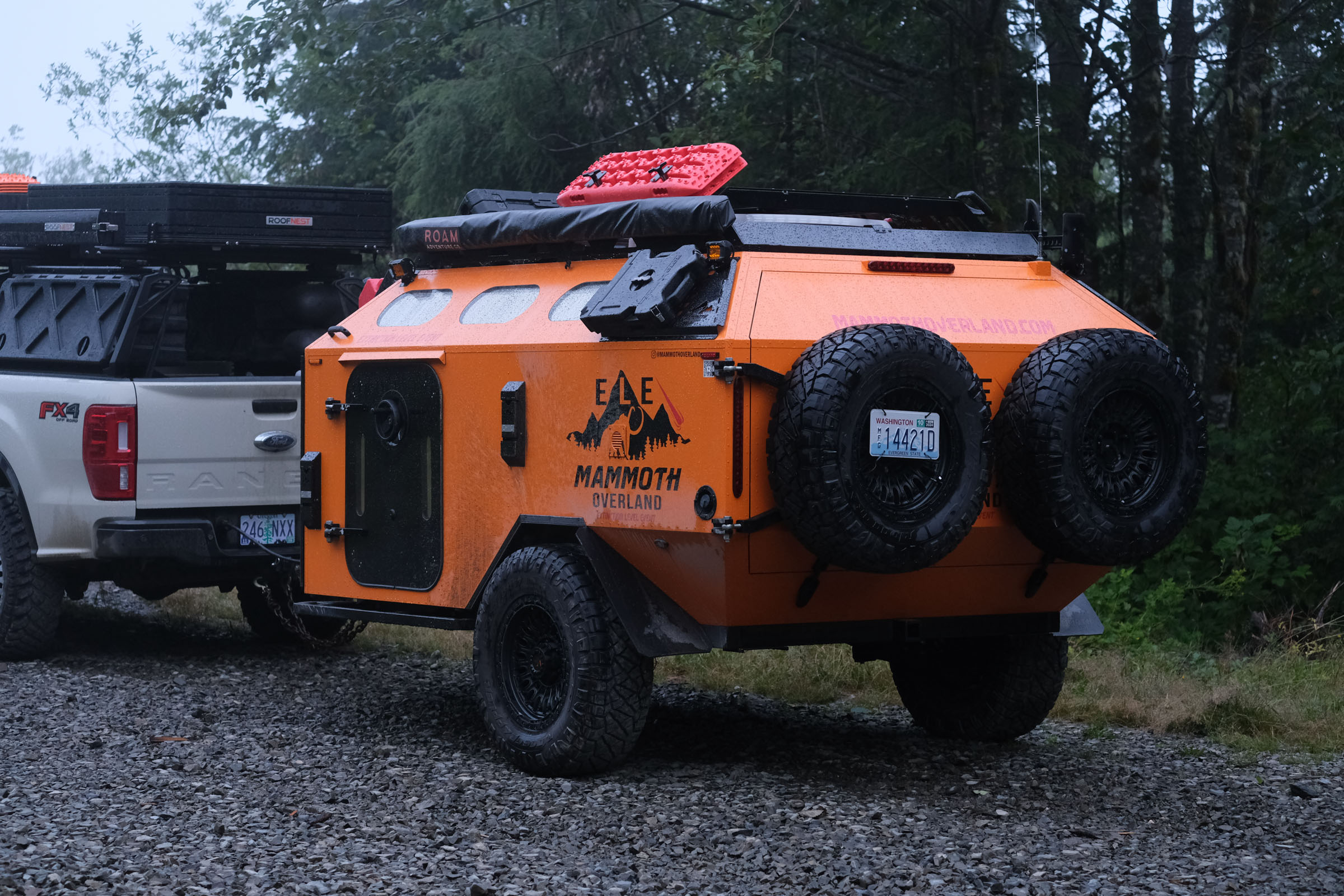It’s a bit of overkill that I found super fun to tow into the woods between Seattle and Bellingham a few weeks ago. It’s big and burly, but it’s light and lithe so you don’t feel like you’re towing around a big burden, like some massive, overbuilt survivalist vehicles that are likely to get stuck at the first sign of true off-roading.
I spent three nights testing out the ELE in the woods of Washington state recently. Here’s what I learned about the ELE, and the company that builds it in its Woodinville, Washington facility.
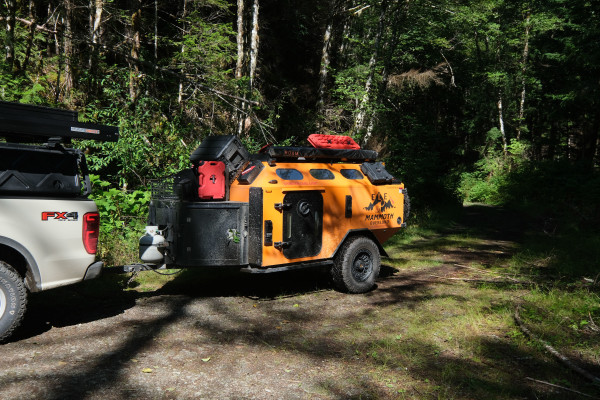
Mammoth Overland Extinction Level Event Specs
Price: $67,000
Bulletproofing upgrade: $25,000
Weight: 2,400 pounds
Suspension: Timbren axle-less trailer suspension
Materials: Steel and rivet
What I like
Easy to tow; comfortable and well-equipped for long-term living; heated, vented, and equipped with air exchanger
What I’d change
Foot of the bed extends underneath shelving, which is tight for big feet
My call
If you’re looking to get off-grid for an extended period of time, the Extinction Level Event is well equipped for whatever adventures you can throw at it. If you’ll be taking the family with you, consider one of Mammoth Overland’s larger trailers, though.
Mammoth Overland Extinction Level Event build
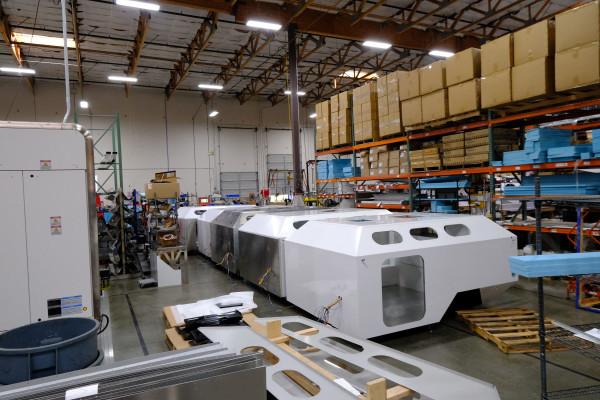
Mammoth Overland was born from Vashon Aircraft, and the fingerprints of aviation construction are all over the ELE. Mammoth put the ELE on the market in 2023 with a monocoque, riveted sheet metal construction, which immediately differentiated it from other market offerings.
That means there’s no internal skeleton. The entire structure is sheet metal reinforced with skins and stringers to keep the trailer light and strong. Mammoth even sources its sheet metal from local and statewide sources, and each trailer is built in-house in Mammoth’s Woodinville, Washington facility.
In fact, Mammoth fabricates just about everything in-house, except for electrical switchplates and other small parts that are more easily purchased in bulk. A visit to the Mammoth Overland mothership reveals scores of employees hard at work fabricating, riveting, finishing, and testing Mammoth trailers.
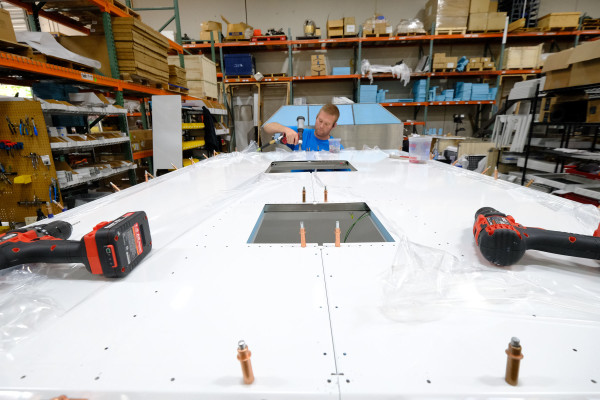
The shell gets sealed off with submarine-style doors, which are exclusive to the ELE. To open and close the doors, you’ll rotate the dial. There are locks, of course, to secure yourself in, or threats out.
The ELE bulletproof option adds a 7/16 thick composite panel, which gets bolted to the inside of the shell. It also adds about 800 to 900 pounds to the trailer, which weighs 2,400 pounds without bulletproofing. This option also requires a suspension upgrade to Timbren’s 5200 HD system rather than the stock 3500 HD setup.
Two full size spare tires are mounted to the rear of the trailer and swing out of the way easily so you can access the kitchen. That kitchen is outfitted with running hot and cold water, a two-burner stove, a fridge, cabinets, and lighting.
Inside, the ELE hosts a ton of nifty features. A television and Starlink internet give you plenty of entertainment options. Built-in cubbies and a shelf offer plenty of storage space. There are plugs galore to charge your devices, all connected to an inverter you can turn on and off as necessary. And the lighting inside changes colors to suit your moods.
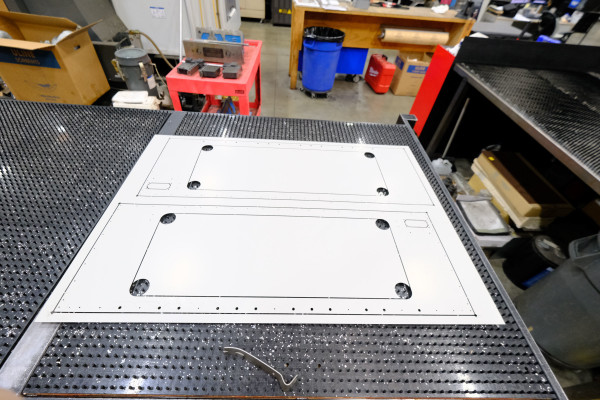
On top of that, there’s also a security camera so you can see what’s happening all around the trailer, right from the comfort of your mattress. If there’s a threat outside your door, don’t sweat it: there’s a button mounted by the door that activates bear spray outside.
From deposit to delivery, you’ll be waiting about a month for your Extinction Level Event, unless you want a custom color. That can add a couple more weeks to the delivery time.
Camping in the Mammoth Overland ELE

I got an unexpectedly healthy amount of time driving around with the Mammoth Overland ELE, thanks to the airlines losing my bike (on a direct flight, no less). After picking up the trailer at Mammoth Overland’s headquarters in Woodinville, I headed north sans-bike to find a place to camp.
I wanted to stay fairly close to Woodinville in case my bike happened to show up, so I ended up at Mt. Pilchuk. The scenery was beautiful, but the drive up isn’t exactly challenging; it was a muddy dirt road, but nothing a two-wheel-drive car couldn’t handle.
That said, I found a nice, quiet place to camp and got to work dissecting the bits and bobs all over the Extinction Level Event.
It’s a compact affair, which makes for quick setup and takedown. In fact, there’s not much at all to do once you arrive at your campsite. If you want to pull the awning out, that’s about as complex as setup gets.
The two full-size spare tires on the rear of the trailer swing out of the way so you can open up the hatch that reveals the kitchen. From there, the refrigerator and sink swing outward. That gives you an L-shaped kitchen, complete with a prep surface, cabinets, running hot water, and a two-burner stove.
I spent most of my evening here, cooking up a more complex dinner than I would normally cook on an overnighter. The kitchen is a comfortable space to cook, after all, and with the hatch open, you’ve got a built-in awning. That came in handy as a misty rain fell.
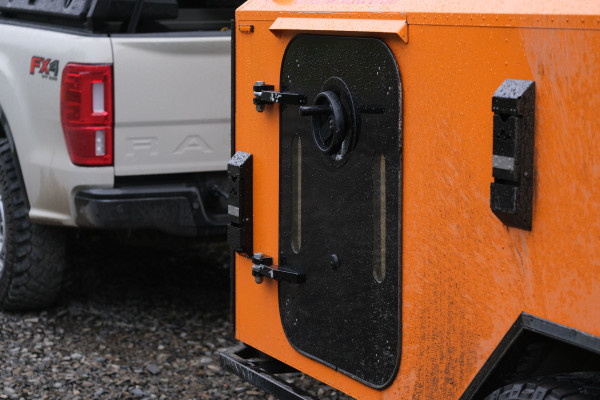
The real winner of the kitchen area is the running water. I loved having hot running water at the touch of a button to clean up my mess after cooking. I was less enthused with the drain — a hose you pull out from under the sink and run to…wherever. I ended up draining my wastewater into a deep pot and digging a hole to dump it in. A gray water tank would be handy here.
That night, it rained steadily. So I did not pop the vent in the roof of the ELE, which would have kept condensation at bay. I did run the air exchanger for a while, but it’s fairly loud, so I didn’t want to run it all night. Consequently, there was a fair bit of condensation inside the ELE when I woke up in the morning. That’s not a big deal, but if you live in wet locales, expect to deal with moisture buildup.
Bells, whistles, and bear spray: ELE standout features
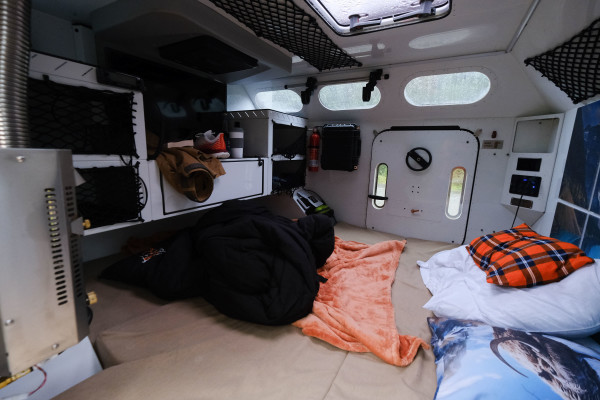
My bike did indeed arrive, a solid ten hours after my flight landed. So a trip back to Woodinville the next morning became an unplanned detour. Consequently, I arrived back up north late in the day, so I opted to camp at a state park.
That provided me with an opportunity to test out some of the creature comforts the Extinction Level Event provides. Generally, I prefer my camp setup to be as simple as possible, but the ELE is geared up for longterm living. If I was living out of the ELE, these creature comforts would certainly come in handy.
The Starlink system, for example, lives in a plastic box on the front of the ELE. It’s easy enough to get it out and set it up, though a faulty cable kept it from working for the duration of my trip.

Inside the ELE, there’s a TV too. Had the Starlink worked, I would have been able to while away a few hours binge-watching Netflix. As it was, I was stuck staring at a blank screen, but this setup is quite comfortable nonetheless: just cozy up in the trailer, kick your feet up, and settle in for a night of entertainment.
On a cold night, this sounds super cool. I can imagine spending a night in the ski area parking lot, watching television as the snow falls. There’s a propane heater in the cabin of the ELE too, so keeping warm on super cold nights is of little concern.
It’s worth noting, too, that once the submarine-style doors are closed, the ELE does an admirable job of keeping out noise. State parks aren’t known for quiet camping, after all, but I didn’t even have to pop in ear plugs that night.
Real off-road with the Extinction Level Event, finally

On my third night, I finally got to give the Mammoth Overland ELE a real test on more rugged terrain. I drove south and west to some secluded roads near Darrington, Washington and got the trailer dirty.
The ELE handles well off-road, as it turns out, which isn’t surprising given its light and lithe mannerisms on road. I was towing it with a Ford Ranger, and that was ample firepower for getting the ELE up steeper, rockier pitches. I wouldn’t go rock crawling with this setup (though overlanders braver than I am would undoubtedly give it a go) but I was more than comfortable towing the ELE up narrow, loose terrain and muddy dirt roads.
One of the drawbacks of any off-road trailer is the inability to turn around on tight roads. It just so happened that a wrong turn put me in exactly that position. I don’t love towing trailers because I prefer the versatility of an enclosed truck, which I can turn around more easily if I dead-end or get stuck somewhere. As it was, I had to do a lot of driving in reverse to rectify my navigation error.
That’s not exclusive to the ELE, of course. It’s just something to note if you’re considering buying any trailer. Research your route ahead of time and make sure there’s either a turnaround big enough for your truck and trailer, or an exit to the road you’re on that won’t require you to turn around at all.
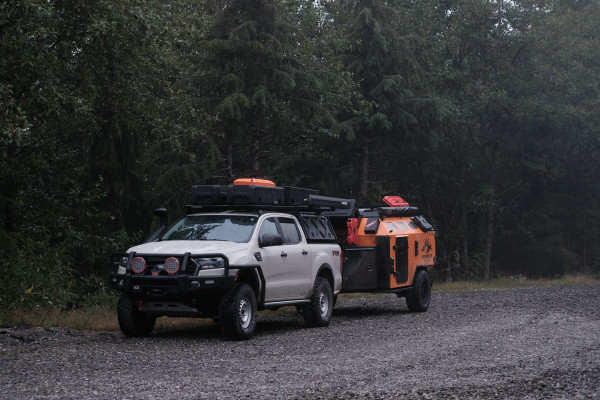
Fortunately, I got myself back on track and found a secluded camping spot for the night. I cooked a meal again, and I really find the kitchen to be a highlight of the ELE. Since it swings out, you end up with an L-shaped kitchen layout, which makes it easy to prep and then cook without finding yourself dropping pans and searching madly for a place to put down a full plate.
After dinner, I crawled into the ELE and read a book (Starlink ruined my Netflix bingeing). I sure do love the ambience of the lighting, and I played around with the different colors until I found something that suited my mood. The ample outlets are great, too, so I can charge my phone, laptop, headlamp, and other accessories without much fuss.
I found the mattress inside very, very comfortable and I got three great nights of sleep inside. But I have one complaint. The mattress extends underneath the shelf below the TV, which means you’ll tuck your feet into that area when you sleep. If you’ve got big feet, or if you thrash a bit while sleeping, you might find this uncomfortable.
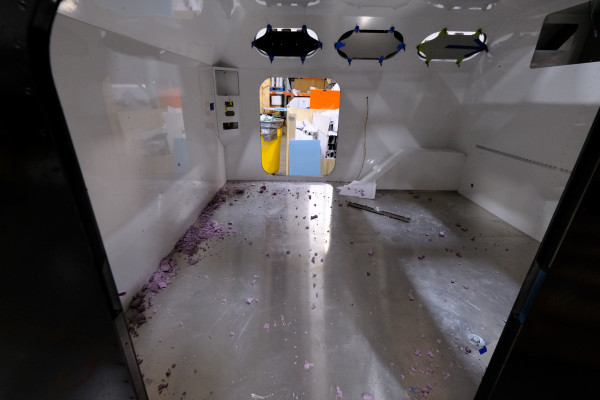
The storage cubbies are quite deep and I ended up putting all my clothing and shoes in them with plenty of room to spare. You could definitely pack for a week or two trip without completely filling the spaces.
While I didn’t get an opportunity to test out the bear spray system — for better or worse — I did use the security camera quite a bit. I didn’t really have a need to, but it was fun to see outside the trailer while I was tucked cozily inside, especially when it was raining out.
Mammoth Overland Extinction Level Event: Final word
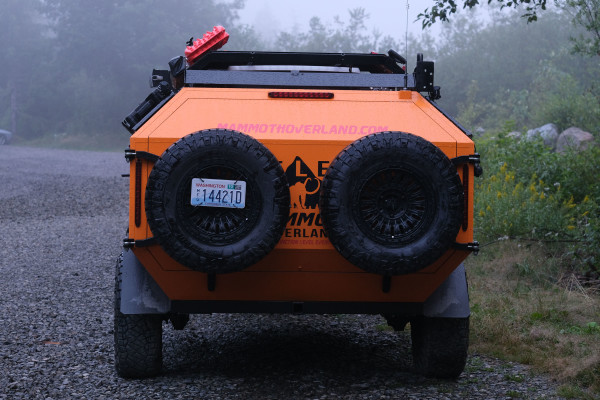
The Mammoth Overland Extinction Level Event makes for some comfy camping, and it’s got some super cool features that make it suitable for long trips in the backcountry. I’m not much of a trailer guy, but I sure did enjoy my three nights in the ELE.
It’s comfortable, most importantly. Though I wish there was more room for my feet while sleeping, the mattress is plush and I found it easy to hang out inside the trailer. It’s spacious, and offers plenty of storage space.
If you’re camping long-term with the family, however, consider one of Mammoth’s larger trailers. The ELE is best for one or two people.
Finally, the novel construction method of the ELE keeps it pretty lightweight, which means you don’t need a full size truck to tow it. You could definitely tow this with an SUV or midsize truck, just be sure to double check your tow rating.
Ultimately, the Mammoth Overland ELE is well constructed, comfortable, easy to handle both on and off-road, and kitted out for real adventures in the wild.
